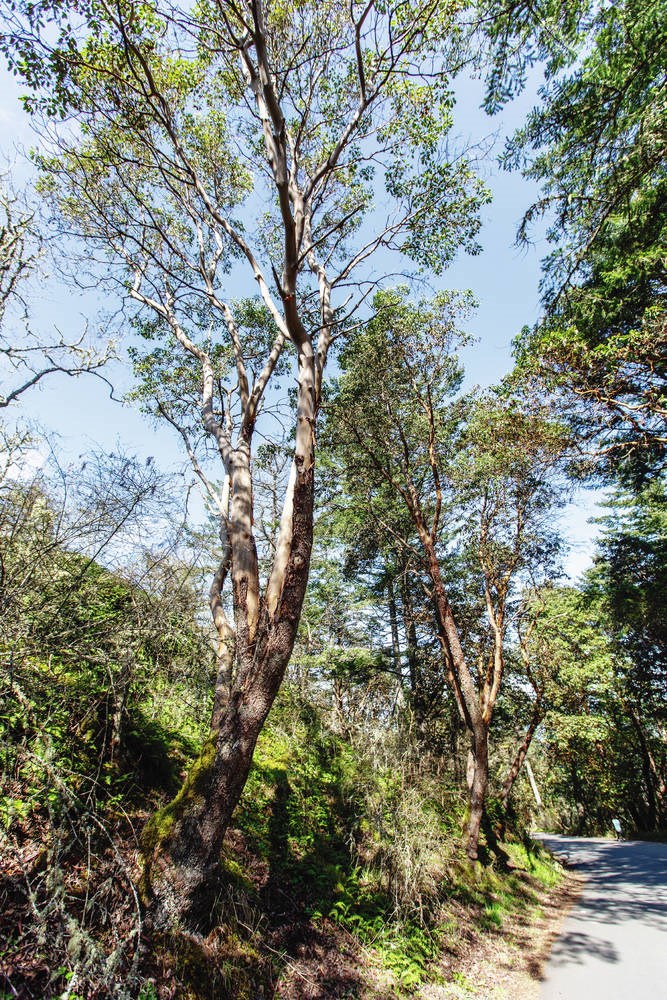Vancouver Island’s cherished arbutus trees are looking a little sickly these days, their normally colourful bark blackened or grey and leaves withering and falling off.
Experts say it’s due to a combination of factors — fungal leaf blights, successive seasons of drought, climate change and human disturbances.
The problem is widespread and some areas are being harder hit than others. Several of the majestic trees have been stricken in Mount Douglas Park, along with others in regional parks such as Frances King and Mount Work and in pockets from Sooke to its northern-most range around Parksville.
Canada’s only broadleaf evergreen tree is in serious trouble, said Metchosin’s Andy McKinnon, a retired professional forester and biologist.
“Everywhere I’ve looked, the arbutus are in a bad state,” McKinnon said Friday. “They are being hammered by blight, a species of fungus that attacks the leaf.”
He said seasons of drought and “well-documented changes in climate” leave the arbutus stressed and unable to fight the fungus, and some of the trees are dying.
The arbutus has been dealing with fungal leaf blight for hundreds of years, McKinnon said. While the organisms haven’t changed, the trees are less hardy and more susceptible to defoliation due to eroding soils, dry summers and stress from human disturbances.
“They are losing the battle and it breaks my heart to see this happen,” said McKinnon. “Five years ago, we had a similar experience and we ended up with a lot of dead arbutus. I think we’re seeing that again now.”
McKinnon and other experts are monitoring trees to determine if the afflicted arbutus are mainly those growing in shallow soils, where moisture isn’t easily maintained.
Most of the Island’s arbutus trees are found in rocky outcroppings near the ocean.
Arbutus menziesii, also known as Pacific Madrone, is a “striking work of nature,” according to The Land Conservancy of British Columbia. They can live to be hundreds of years old. Their flowers support pollinating insects and their berries are an important food source for robins, waxwings, thrushes and woodpeckers.
Arbutus bark regenerates new layers every year and its colour varies, depending on its age, ranging from brilliant chartreuse to a deep red.
But the blight is turning many of the distinctive trees into drab shadows on the landscape.
“When you see an arbutus going grey or black, that’s an advanced onset of [disease] and it’s a challenge for an arbutus to come back from that,” said Andrew Connell, an arborist with the District of Saanich.
Connell is hopeful many of the trees will bounce back.
He said if people have arbutus trees on their properties, they should water them during dry periods, reduce pruning and do what they can to reduce climate change.
He discourages transplanting, saying arbutus don’t survive moves well, and he recommends planting seedlings.
Saanich’s tree bylaws protect arbutus trees as small as four centimetres in diameter, and the district examines any development that involves removal of the trees. Garry oak, Pacific dogwood and yew trees are also protected.
McKinnon, a Metchosin councillor, said many of the region’s councils could do a lot more to protect arbutus trees, saying Langford and Colwood developments have wiped out most of the trees in those areas.
Duncan Frater, who lives downtown and has been taking regular hikes during the pandemic, said he started noticing the sickly state of arbutus trees during trips this spring to Mount Work Regional Park.
“Lots of us are hiking these days and it’s obvious that the arbutus trees are going through some kind of change,” he said. “They are really magnificent trees. The bark is beautiful and changes colour when it rains. Now a lot of them don’t look well.”



